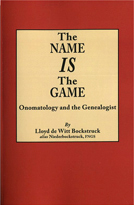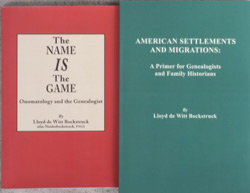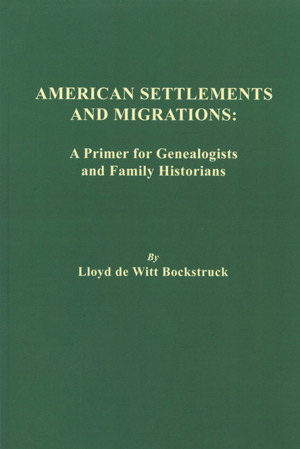Family Roots Publishing has put together a bundle of two recently published Lloyd Bockstruck books – one dealing with Settlements and Migration in America & the other the closely related subject of Names. We’ve discounted the bundle by 10%. The following books are included:
- American Settlements and Migrations; A Primer for Genealogists and Family Historians; by Lloyd de Witt Bockstruck
- The Name Is the Game: Onomatology and the Genealogist; by Lloyd de Witt Bockstruck
Click on the links to view full descriptions of either book at their respective pages, or to purchase just the one item. Return to this page to order the bundle.
Following are reviews of each of the books:
GPC has just released a new guide from Lloyd de Witt Bockstruck. This softbound book is titled American Settlements and Migrations: A Primer for Genealogists and Family Historians.
The book provides a synopsis of the original patterns of settlement and migration for the United States. Mr. Bockstruck discusses each of the 50 states, however, his emphasis is on the states and territories that were established between the colonial period and the middle of the nineteenth century. For each state the author examines pioneers’ places of origin, reasons for settlement, specific places of settlement in America, names of pioneering families, migrations within and between states, and more. Equally important, throughout the volume he names the key sources for further research.
The study of migration is inextricably intertwined with family history. By combining a knowledge of history and geography, therefore, the family historian can extend the family pedigree across the country. Every detail represents a potential clue to an elusive ancestor, from the name of a shipping line, port of embarkation, and clusters of fellow passengers, to the nature of soil available to the colonist, church membership, and status of roadways.
Some members of the family may not have ventured away from the ancestral home. Others went westward but did not continue as far as some of their kinfolk. They may have generated the records further inland that would enable the family historian to bridge an ancestral geographical gap. Finding earlier places of residence could enable one to determine the place of nativity of an ancestor. Following such paths could enable one to locate relatives who remained in the East or dropped off earlier along the migration route, thereby identifying the immigrant or colonist who founded the family in the New World and perhaps the ancestral home in the Old World as well.
The study of migration/immigration follows several principles. Firstly, one must understand the local history of one’s ancestral homes. For example, as late as 1950, the state possessing greatest percentage of residents of British descent was Utah. Why? Utah was settled by Mormons, and this relatively new religious group was mostly composed of New England Puritan stock. Moreover, that church’s first missionary efforts abroad were in conducted in the British Isles, and those converts joined them in Utah.
Secondly, migrations are also tied to similar climatic belts. Colonists and immigrants often sought out lands that were capable of growing the crops with which they were familiar, as in the case of Scandinavian settlement in Minnesota and the Dakotas.
Thirdly, migration rests upon forces that draw immigrants to a new home. It may also apply to those forces that drove them away from their home. In some instances both aspects may apply. For instance, more than 150,000 natives of Virginia were living in the states of the Old Northwest Territory in 1850—an area accessible to them and possessing terrain and soils with which they were familiar.
Still other factors impinging on migration and settlement include available modes of transportation, religious preference or ethnicity, economic factors such as famines and floods, and foreign wars, revolutions, and other aspects of statecraft. Bockstruck contrasts colonial migrations, for example, with those following American Independence. During the colonial period, individuals and groups moved from the southern colonies to the northern colonies, and vice versa. Until the 1750s, colonists utilized sailing ships as the primary mode of transportation between colonies. They did not move from the East to the West until after the French and Indian War, when the Braddock and Forbes roads were built to enable the military forces to go into the interior to challenge the French in the Ohio River Valley. Such roads were necessary to move heavy military equipment, such as canons, and materiel to the war front.
American Settlements and Migrations is arranged by region and thereunder by state. Each chapter outlines not only the events, persons, and forces that contributed to a state’s settlement but also offers untold clues to the reader’s own ancestors. Might an 18th-century South Carolina forebear have been part of the British expulsion of the French from Nova Scotia? Was your Welsh ancestor part of the Pennsylvania migration to work in the Knoxville, Tennessee mining industry? Your Irish Famine-era ancestor was living in Boston in 1860, but is the gap in his genealogy attributable to the fact that he might have entered North America through the Canadian Port of St. John, Newfoundland. These are just some of hundreds of possibilities Mr. Bockstruck gets you to consider. His new primer may be just the clue finder you have been looking for.
In my review of the volume, I found that virtually hundreds of resources are found within the text – all with full titles, and authors. This makes it easy for the genealogist to find the item with the publishers, or a nearby library genealogy collection. By the way, you can find books in libraries near you within seconds by typing the title into the search engine at http://www.worldcat.org/. Find the book, and click on it. Enter your location zip code (under Find a Copy in a Library). Bingo!
The only issue I have with the volume is that the font is a bit small for my old and tired eyes. But reading the volume in bright lighting made my reading pleasurable – and I learned many things that I didn’t know previously.
Order your volume by clicking on the link:
American Settlements and Migrations; A Primer for Genealogists and Family Historians; by Lloyd de Witt Bockstruck; 2017; 108 pp; 6×9; paperback; ISBN: 9780806358314; Item #:CF8125D
The following is from the Table of Contents – the abbreviations are mine:
- Chapter One: American Settlements and Migrations in America
- Chapter Two. New England – MA, CT, RI, Providence Plantations, VT, ME
- Chapter Three. West Indies
- Chapter Four. The Middle Colonies – NY, NJ, PA, DE, MD
- Chapter Five. The Southern Colonies – VA, WV, NC, SC, GA
- Chapter Six. The Impact of the Revolutionary War
- Chapter Seven. Post Revolutionary War Settlements – FL, KY, TN
- Chapter Eight. The Old Northwest – OH, IN, IL, MI, WI, MN
- Chapter Nine. The Old Southwest – AL, MI, LA
- Chapter Ten. The Trans-Mississippi West – IA, MO, AR
- Chapter Eleven. The West – TX, KS, NE, OK, UT, NM. AZ, NV, CO, ND, SD, WY, ID
- Chapter Twelve. The Pacific Coast – OR, WA, CA
- Chapter Thirteen. Alaska, Hawaii and Canadian Settlements – AL, HI, QC, NS, ON
Order your volume by clicking on the link:
American Settlements and Migrations; A Primer for Genealogists and Family Historians; by Lloyd de Witt Bockstruck; 2017; 108 pp; 6×9; paperback; ISBN: 9780806358314; Item #:CF8125D
Purchase the bundle by clicking here or on the illustration.
_________________________
 Two hundred years ago no parent would have named a child for a favorite movie star. There were no movies. However, naming a child for an historical figure, like George after George Washington, was not uncommon. Other naming practice common in the past would seldom be considered today. However, understanding such practices may help a genealogists better identify their ancestors. For example, using an uxornecronym. An uxornecronym is a name given to the first daughter born into a marriage were the name honors a previous wife. Such practices would be less common in a society were divorce is the primary reason for having previous marriages, but not so in a time when death, especially in child birth, would have left an empty place in a home to be filled by a second marriage. Genealogists looking to better understand and trace their ancestors by their names may benefit greatly from The Name IS the Game: Onomatology and the Genealogists, a new book by Lloyd de Witt Bockstruck.
Two hundred years ago no parent would have named a child for a favorite movie star. There were no movies. However, naming a child for an historical figure, like George after George Washington, was not uncommon. Other naming practice common in the past would seldom be considered today. However, understanding such practices may help a genealogists better identify their ancestors. For example, using an uxornecronym. An uxornecronym is a name given to the first daughter born into a marriage were the name honors a previous wife. Such practices would be less common in a society were divorce is the primary reason for having previous marriages, but not so in a time when death, especially in child birth, would have left an empty place in a home to be filled by a second marriage. Genealogists looking to better understand and trace their ancestors by their names may benefit greatly from The Name IS the Game: Onomatology and the Genealogists, a new book by Lloyd de Witt Bockstruck.
What is Onomatology? Where etymology is the study of the origin and history of words, onomatology is the same for names. Bockstruck explains, “onomatology is the study of names. It involves both forenames, commonly called first, second, or middle names, and family names or surnames. It also includes nicknames and place names which in the United States are often named for individuals.” He also makes the important distinction, “the study of onomatology is one based on records over centuries and requires an awareness of a multitude of changes in names.” This book provides, at least, the basics of onomatology for genealogists.
The Name IS the Game is broken into five chapters. The first acts as introduction. The second and third chapters examine given names and surnames, respectively. These chapters represent the bulk of the book and cover all types of naming practices over centuries of Europe and the United States. The last two chapters cover toponyms, place names, and provide a selected bibliography for further reference.
I have provided, below, and expanded table of contents. The list should demonstrate just how much this book covers, especially regarding surnames.
Table of Contents (expanded)
Chapter 1 Introduction
Chapter 2 Forenames
- Ethnic Clues in Forenames
- Forename or a Title
- The Maiden Name of a Mother as a Forename
- Forename Clues
- Diminutives
- Diminutive Abbreviations
- Forename Equivalents
- Multiple Forenames
- Uxornecronyms
- Ambisexual Forenames
- Postponing the Bestowing of Forenames
- Repetition of Forenames
- Forename Clues
- Hagiographic Forenames
- Naming Patterns
- Optical Mis-recognition
- Forenames from Historical Figures
- Initials
- Renaming of a Living Child
Chapter 3 Surnames
- Maiden Names
- Spelling Fixation
- Surname Confusion
- Misinterpretation of Letters of Surnames
- The Un-aspirated Initial Letter of Surnames
- Pronunciations
- The Terminal “G”
- Nee, Alias, and Genannt
- Adoption of a Step-parent’s Surname
- Military Influence on Surnames
- From English to Another Language
- From One European Language to Another
- The Dit Name
- Dialects and Minorities
- Dutch Surnames
- Abbreviations of Surnames
- The Crossed Tail of the Letter P
- The Long “S”
- The Female Title of Mrs.
- Idem Sonans
- Translation into English
- Surname Shortening
- The Letters “R” and “L”
- “Ou” and “Wh”
- Gender and Surnames
- Ethnic Clues
- Statutory Changes
- District and County Court Changes of Names
- Multiple Independent Appearances
- Spanish
- African-American
- Jewish
- American Indian Surnames
Chapter 4 Toponyms
Chapter 5 Selected Bibliography of Legal Changes of Names
Copies of The Name IS the Game: Onomatology and the Genealogist are available from Family Roots Publishing.
Purchase the bundle by clicking here or on the illustration. Need just one of the books?

